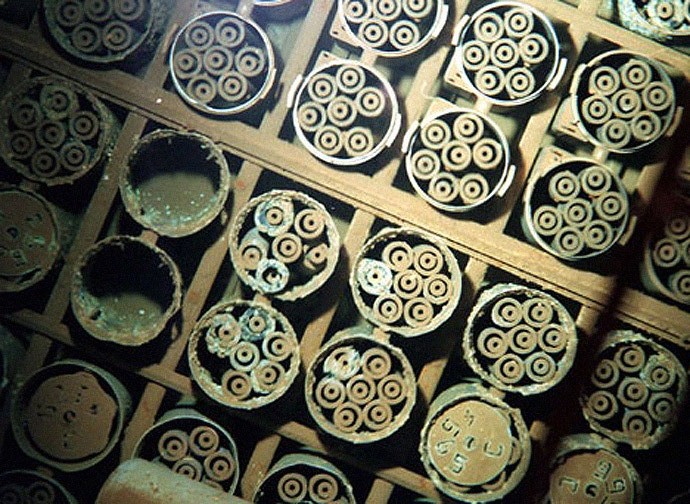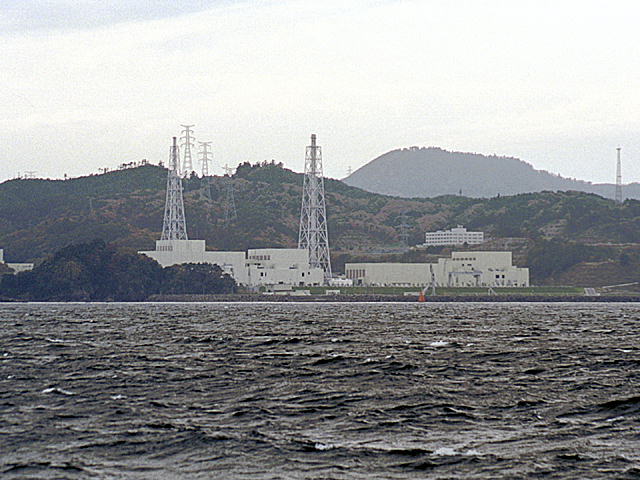|
Japan Nuclear Cycle Development Institute
The Japan Nuclear Cycle Development Institute (JNC) was formed in October 1998 to develop advanced nuclear energy technology to complete the nuclear fuel cycle, particularly fast breeder reactors, advanced reprocessing, plutonium fuel fabrication and high-level radioactive waste management. It succeeded the Power Reactor and Nuclear Fuel Development Corporation (PNC). It merged with the Japan Atomic Energy Research Institute (JAERI) in October 2005, becoming the Japan Atomic Energy Agency (JAEA). See also * Nuclear power in Japan Prior to the 2011 Tōhoku earthquake and tsunami, Japan had generated 30% of its electrical power from nuclear reactors and planned to increase that share to 40%. Nuclear power energy was a national strategic priority in Japan. , of the 54 nu ... References Official siteon the JAEA site History of Japan Nuclear Cycle Development Institute {{Authority control Nuclear technology organizations of Japan ... [...More Info...] [...Related Items...] OR: [Wikipedia] [Google] [Baidu] |
Nuclear Reactor Technology
A nuclear reactor is a device used to initiate and control a fission nuclear chain reaction or nuclear fusion reactions. Nuclear reactors are used at nuclear power plants for electricity generation and in nuclear marine propulsion. Heat from nuclear fission is passed to a working fluid (water or gas), which in turn runs through steam turbines. These either drive a ship's propellers or turn electrical generators' shafts. Nuclear generated steam in principle can be used for industrial process heat or for district heating. Some reactors are used to produce isotopes for medical and industrial use, or for production of weapons-grade plutonium. , the International Atomic Energy Agency reports there are 422 nuclear power reactors and 223 nuclear research reactors in operation around the world. In the early era of nuclear reactors (1940s), a reactor was known as a nuclear pile or atomic pile (so-called because the graphite moderator blocks of the first reactor were placed into a tall pi ... [...More Info...] [...Related Items...] OR: [Wikipedia] [Google] [Baidu] |
Nuclear Fuel Cycle
The nuclear fuel cycle, also called nuclear fuel chain, is the progression of nuclear fuel through a series of differing stages. It consists of steps in the ''front end'', which are the preparation of the fuel, steps in the ''service period'' in which the fuel is used during reactor operation, and steps in the ''back end'', which are necessary to safely manage, contain, and either reprocess or dispose of spent nuclear fuel. If spent fuel is not reprocessed, the fuel cycle is referred to as an ''open fuel cycle'' (or a ''once-through fuel cycle''); if the spent fuel is reprocessed, it is referred to as a ''closed fuel cycle''. Basic concepts Nuclear power relies on fissionable material that can sustain a chain reaction with neutrons. Examples of such materials include uranium and plutonium. Most nuclear reactors use a moderator to lower the kinetic energy of the neutrons and increase the probability that fission will occur. This allows reactors to use material with far lower con ... [...More Info...] [...Related Items...] OR: [Wikipedia] [Google] [Baidu] |
Fast Breeder Reactor
A breeder reactor is a nuclear reactor that generates more fissile material than it consumes. Breeder reactors achieve this because their neutron economy is high enough to create more fissile fuel than they use, by irradiation of a fertile material, such as uranium-238 or thorium-232, that is loaded into the reactor along with fissile fuel. Breeders were at first found attractive because they made more complete use of uranium fuel than light water reactors, but interest declined after the 1960s as more uranium reserves were found,Helmreich, J.E. ''Gathering Rare Ores: The Diplomacy of Uranium Acquisition, 1943–1954'', Princeton UP, 1986: ch. 10 and new methods of uranium enrichment reduced fuel costs. Fuel efficiency and types of nuclear waste Breeder reactors could, in principle, extract almost all of the energy contained in uranium or thorium, decreasing fuel requirements by a factor of 100 compared to widely used once-through light water reactors, which extract less tha ... [...More Info...] [...Related Items...] OR: [Wikipedia] [Google] [Baidu] |
Nuclear Reprocessing
Nuclear reprocessing is the chemical separation of fission products and actinides from spent nuclear fuel. Originally, reprocessing was used solely to extract plutonium for producing nuclear weapons. With commercialization of nuclear power, the reprocessed plutonium was recycled back into MOX nuclear fuel for thermal reactors. The reprocessed uranium, also known as the spent fuel material, can in principle also be re-used as fuel, but that is only economical when uranium supply is low and prices are high. A breeder reactor is not restricted to using recycled plutonium and uranium. It can employ all the actinides, closing the nuclear fuel cycle and potentially multiplying the energy extracted from natural uranium by about 60 times. Reprocessing must be highly controlled and carefully executed in advanced facilities by highly specialized personnel. Fuel bundles which arrive at the sites from nuclear power plants (after having cooled down for several years) are completely dissolv ... [...More Info...] [...Related Items...] OR: [Wikipedia] [Google] [Baidu] |
Plutonium
Plutonium is a radioactive chemical element with the symbol Pu and atomic number 94. It is an actinide metal of silvery-gray appearance that tarnishes when exposed to air, and forms a dull coating when oxidized. The element normally exhibits six allotropes and four oxidation states. It reacts with carbon, halogens, nitrogen, silicon, and hydrogen. When exposed to moist air, it forms oxides and hydrides that can expand the sample up to 70% in volume, which in turn flake off as a powder that is pyrophoric. It is radioactive and can accumulate in bones, which makes the handling of plutonium dangerous. Plutonium was first synthetically produced and isolated in late 1940 and early 1941, by a deuteron bombardment of uranium-238 in the cyclotron at the University of California, Berkeley. First, neptunium-238 ( half-life 2.1 days) was synthesized, which subsequently beta-decayed to form the new element with atomic number 94 and atomic weight 238 (half-life 88 years). Since ... [...More Info...] [...Related Items...] OR: [Wikipedia] [Google] [Baidu] |
High-level Radioactive Waste Management
High-level radioactive waste management concerns how radioactive materials created during production of nuclear power and nuclear weapons are dealt with. Radioactive waste contains a mixture of short-lived and long-lived nuclides, as well as non-radioactive nuclides. There was reportedly some of high-level nuclear waste stored in the United States in 2002. The most troublesome transuranic elements in spent fuel are neptunium-237 (half-life two million years) and plutonium-239 (half-life 24,000 years). Consequently, high-level radioactive waste requires sophisticated treatment and management to successfully isolate it from the biosphere. This usually necessitates treatment, followed by a long-term management strategy involving permanent storage, disposal or transformation of the waste into a non-toxic form. Radioactive decay follows the half-life rule, which means that the rate of decay is inversely proportional to the duration of decay. In other words, the radiation from a lo ... [...More Info...] [...Related Items...] OR: [Wikipedia] [Google] [Baidu] |
Power Reactor And Nuclear Fuel Development Corporation
The or for short, was a Japanese nuclear energy research organization established 2 October 1967 with the Atomic Fuel Corporation as its parent organization and disbanded in 1998 to be restructured as the Japan Nuclear Cycle Development Institute. The organization specialized in special Breeder reactors and the Advanced Thermal Reactor. It also owned a nuclear reprocessing facility and its activities included uranium exploration in Australia and disposal of high-level waste. Outline In the fast-growing 1960s Japanese business world, domestic reactor technology was mostly undeveloped so importing reactor designs and nuclear fuel proved to be the best economic option. Uranium enrichment technology at the time also had military secrets associated with it, making importing a necessity. Since Japan had very few hydraulic energy resources, breeder reactors and renewable energy were attractive technologies. However, the organization existing at the time to do such research, the Japan ... [...More Info...] [...Related Items...] OR: [Wikipedia] [Google] [Baidu] |
Japan Atomic Energy Research Institute
The Japan Atomic Energy Research Institute ( ja, 日本原子力研究所) (JAERI) is a former semi-governmental organization that existed for the purpose of further nuclear power in Japan. It was created in June 1956 by the Atomic Energy Basic Law. It merged with Japan Nuclear Cycle Development Institute and became Japan Atomic Energy Agency on October 1, 2005, which currently carries out the purpose outlined in the law. It was called Genken (原研) for short. Development A small number of researchers in Japan studied at Argonne National Laboratory in America with the purpose of gaining knowledge that could be taken back to Japan in 1955. Kinichi Torikai was one of those researchers, and he later became president of JAERI. After returning, facilities for nuclear research were established in Tōkai, Ibaraki. In the 1950s, it was decided that individual electric utilities would import reactor types to meet the rapidly increasing demand for energy in the post-war Japan. In Septe ... [...More Info...] [...Related Items...] OR: [Wikipedia] [Google] [Baidu] |
Japan Atomic Energy Agency
The is an Independent Administrative Institution formed on October 1, 2005 by a merger of two previous semi-governmental organizations. While it inherited the activities of both JNC and JAERI, it also inherited the nickname of JAERI, "Genken" 原研, an abbreviated word for "nuclear research". On April 10, 2007, JAEA officially joined the GNEP alliance. The other members in the alliance are Areva, Washington Group International and BWX. It is expected that the experience gained from the Rokkasho centrifuge enrichment plant will be a key contribution from JAEA. On April 1, 2016, JAEA transferred some of its laboratories to the National Institute of Radiological Sciences (NIRS), and the NIRS body was renamed to the National Institutes for Quantum and Radiological Science and Technology (QST) which includes existing laboratories of the NIRS. In 2018 JAEA estimated it would need about 1.9 trillion yen ($17.1 billion) to decommission 79 facilities over 70 years. Overview *Est ... [...More Info...] [...Related Items...] OR: [Wikipedia] [Google] [Baidu] |
Nuclear Power In Japan
Prior to the 2011 Tōhoku earthquake and tsunami, Japan had generated 30% of its electrical power from nuclear reactors and planned to increase that share to 40%. Nuclear power energy was a national strategic priority in Japan. , of the 54 nuclear reactors in Japan, there were 42 operable reactors but only 9 reactors in 5 power plants were actually operating. A total of 24 reactors are scheduled for decommissioning or are in the process of being decommissioned. Others are in the process of being reactivated, or are undergoing modifications aimed to improve resiliency against natural disasters; Japan's 2030 energy goals posit that at least 33 will be reactivated by a later date. Though all of Japan's nuclear reactors successfully withstood shaking from the Tohoku earthquake, flooding from the ensuing tsunami caused the failure of cooling systems at the Fukushima I Nuclear Power Plant on 11 March 2011. Japan's first-ever nuclear emergency was declared, and 140,000 residents w ... [...More Info...] [...Related Items...] OR: [Wikipedia] [Google] [Baidu] |

_(cropped).jpg)




